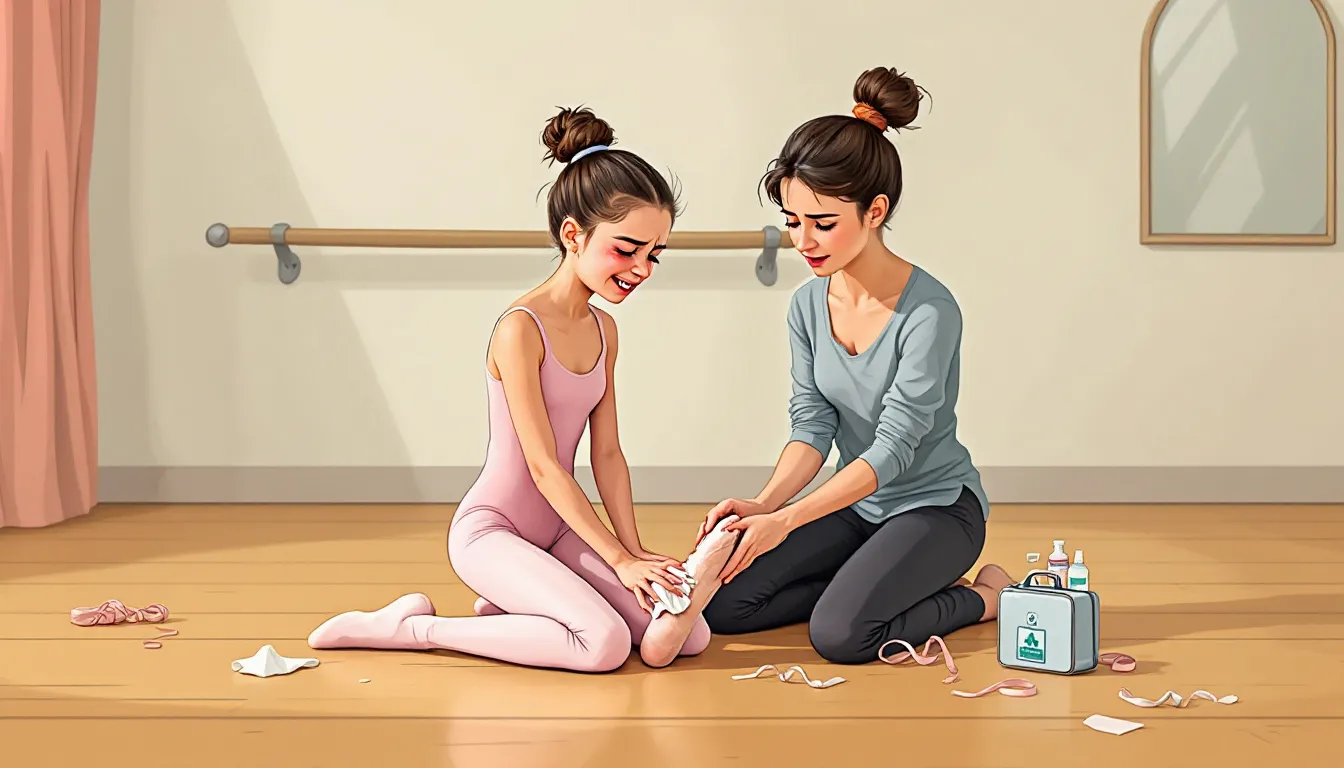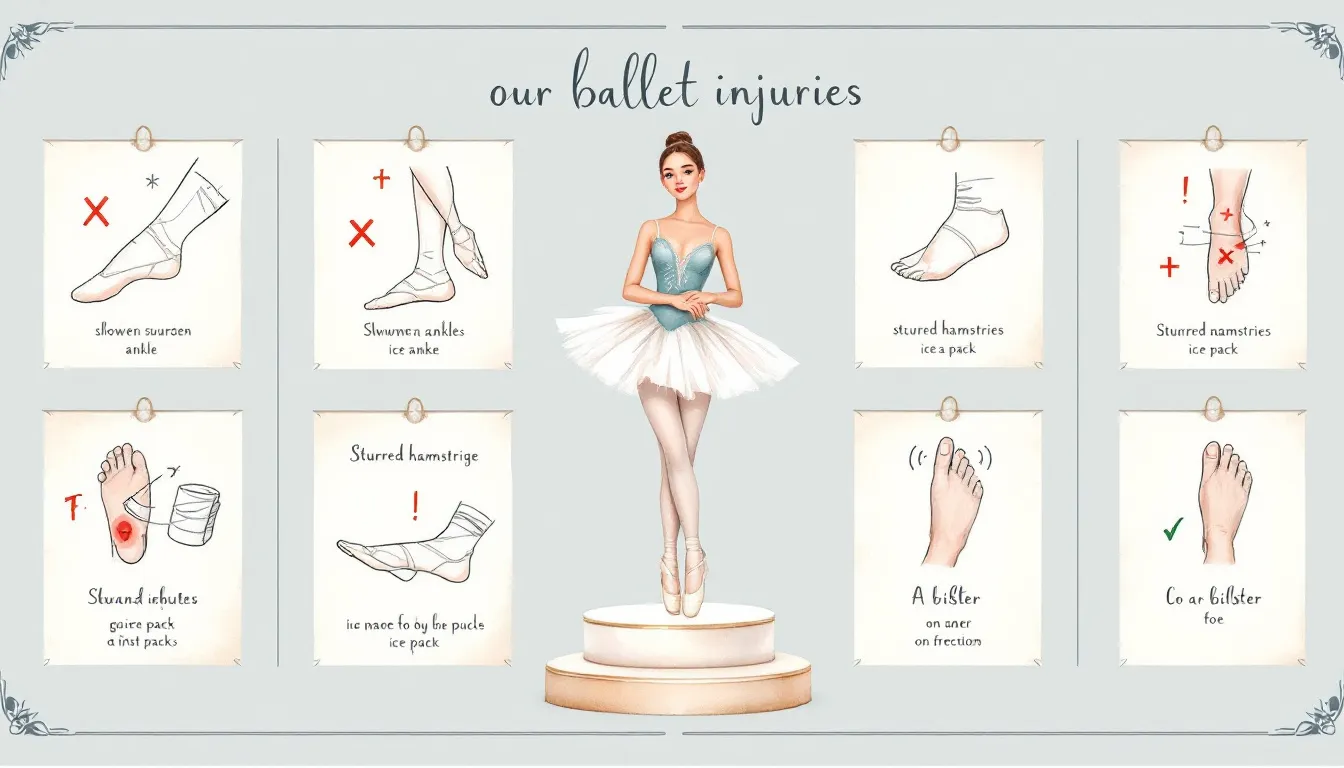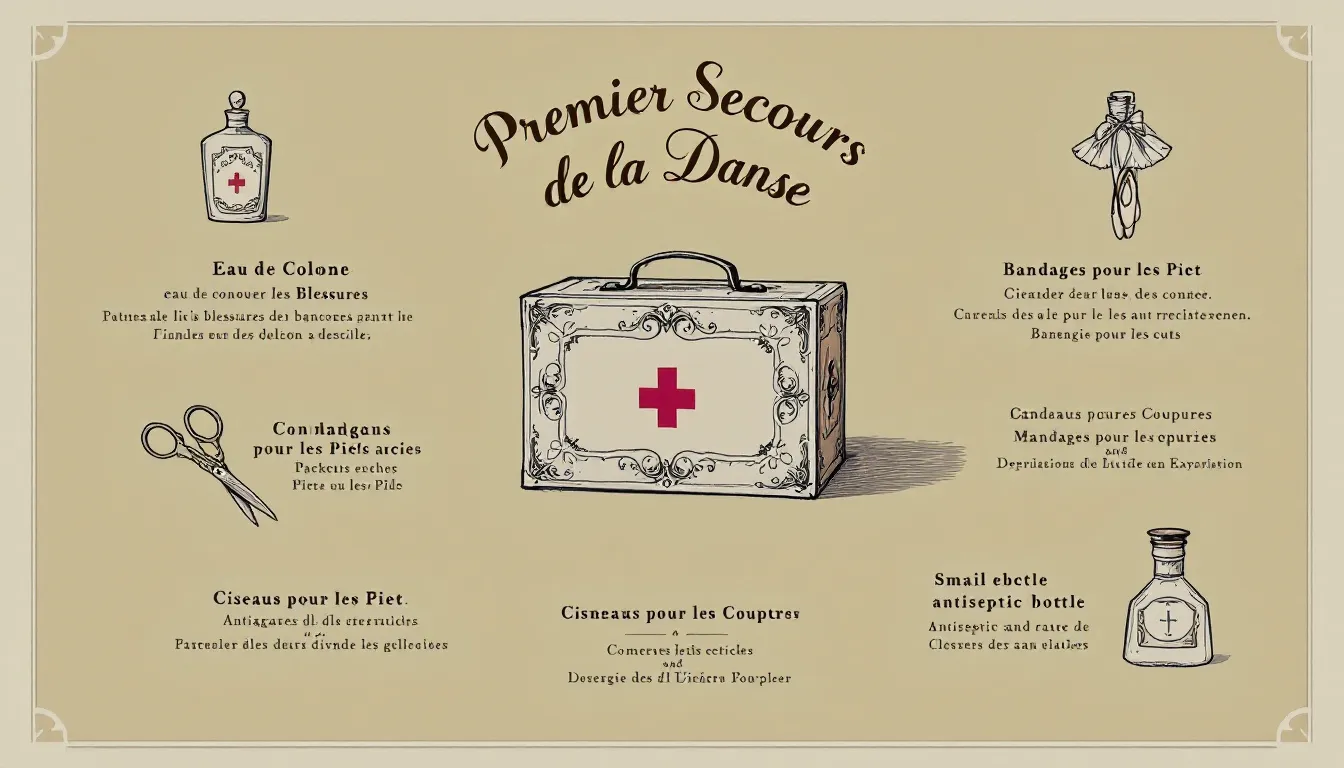
Knowing first aid for ballet injuries is essential if you’re a dancer. This guide will help you handle common dance and ballet injuries, with immediate care techniques like protection, rest, and ice application. Learn how to quickly manage sprains, shin splints, and other injuries to ensure a swift recovery and prevent long-term damage.
Key Takeaways
- The PRICED method (Protection, Rest, Ice, Compression, Elevation, Diagnosis) is essential for managing acute ballet injuries, significantly aiding recovery by limiting inflammation and pain.
- Recognizing warning signs of injury, such as persistent pain or swelling, is critical for preventing long-term complications and ensuring timely medical intervention.
- A well-stocked first aid kit, including basic supplies, cold therapy tools, and supportive gear, is vital for prompt injury management and contributes to a dancer’s quick recovery.
Introduction to Dance Injuries
Dance injuries are an unfortunate but common aspect of a dancer’s journey, affecting performers of all ages and skill levels. The physical demands of dance—requiring strength, flexibility, and endurance—can stress the body significantly, making dancers particularly vulnerable to various injuries. Among the most common dance injuries are ankle sprains, knee injuries, stress fractures, and tendonitis. These often result from repetitive stress, improper landing techniques, and insufficient rest between training sessions.
Understanding the causes and types of dance injuries is essential for prevention and effective management. Repetitive movements and overuse, often due to repetitive stress, can lead to tissue damage, while improper landing from jumps or turns increases the risk of acute injuries. Insufficient rest and recovery time further compound these risks, potentially leading to more serious issues that require extended rehabilitation.
By adopting injury prevention strategies, such as proper warm-up routines, cross-training, and listening to their bodies, dancers can significantly reduce their risk of injury. Seeking professional medical advice when an injury occurs is crucial for accurate diagnosis and a successful rehabilitation process. With the right approach, dancers can recover fully and return to their passion stronger and more resilient.
Immediate Response to Acute Ballet Injuries

The speed and effectiveness of your response to a dance injury can significantly impact your recovery. Acute injuries, such as sprained ankles or shin splints, require immediate attention to mitigate their severity for an effective recovery. The PRICED method is a comprehensive approach to managing these injuries and stands for:
- Protection
- Rest
- Ice
- Compression
- Elevation
- Diagnosis
It aims to limit inflammation and pain while guiding the ongoing care needed for recovery. When an injury occurs, the body’s natural response is to initiate inflammation; during this process, the body releases chemicals that cause swelling and pain as part of the healing process, especially if tight muscles are involved.
Addressing acute injuries promptly reduces pain and swelling and sets the stage for smoother recovery. This section will delve into the PRICED method’s initial steps—Protection, Rest, and Ice Application—essential for any dancer’s immediate injury care toolkit, particularly for ankle injuries.
Protection
Protection is the initial step in injury prevention following an acute injury. Adequately protecting the injured part, especially in cakle injuries, prevents further damage and aids in successful rehabilitation. Using splints or wraps helps maintain stability and supports the injured area, initiating healing.
Supports like braces or wraps help dancers maintain stability and proper form during recovery. This helps in the immediate injury care and plays a significant role in the longer-term rehabilitation process.
Proper knowledge and tools in your invaluable first aid guide and kit make a significant difference in managing and recovering from an injury.
Rest
Rest is fundamental to recovery. Slowing down and resting the injured part avoids further trauma. Proper rest activates the body’s natural healing mechanisms more effectively.
Insufficient rest can prolong recovery and exacerbate the injury, especially when dancers are inactive for extended periods. Allowing time for healing ensures that dancers do not place continual stress on the injured tissue, facilitating successful rehabilitation.
Ice Application
Applying ice reduces swelling and alleviates pain in the injured area. Apply ice in 20-minute intervals for effective results, particularly when dealing with injuries to the Achilles tendon. This reduces inflammation, alleviates muscle soreness, and provides immediate pain relief, crucial in early injury care.
Avoiding Further Damage Post-Injury

Preventing further damage post-injury, especially in cases of muscle strains, is as important as immediate treatment. Proper recovery strategies minimize long-term damage and facilitate smoother healing. Muscle soreness is a normal part of post-exercise recovery and typically resolves within 24-48 hours; however, if pain or discomfort persists beyond this period, it may indicate a more serious injury that requires medical attention. Incorrectly managed injuries like ankle sprains can lead to long-term instability, making appropriate care essential.
This section will explore strategies to avoid exacerbating injuries, focusing on the HARM protocol, prevention tips, and recognizing warning signs that indicate the need for professional medical advice.
Avoid HARM
Please avoid the following immediately after an injury, as they can worsen the injury by increasing blood flow and inflammation, and refer to these prevention tips afterward.
- Heat: promotes healing later, but massage increases swelling in the initial phase
- Alcohol
- Running
- Massage
Dancers must stop dancing immediately and restrict movement of the injured area to avoid additional damage. Avoiding these activities reduces swelling and facilitates healing, making it an invaluable first aid tip for dancers.
Recognizing Warning Signs
Recognizing warning signs is critical for injury prevention. Persistent pain often signals that an injury has occurred, requiring medical attention. Consulting a medical professional, especially in dance medicine, is essential to ensure proper diagnosis and treatment. Ignoring these signs can lead to severe complications and extend recovery time.
Proper care and rehabilitation speed up recovery and reduce the likelihood of future injuries. Vigilance and proactivity ensure effective injury prevention strategies and care.
Common Ballet Injuries and Their First Aid

Ballet’s demanding physical requirements often lead to common dance injuries. Every dancer must understand these injuries and their first aid. Among the most frequent ballet injuries are sprained ankles, shin splints, and conditions affecting the Achilles tendon, such as tendonitis. Knee injuries, such as patellofemoral pain syndrome and issues involving the patellar tendon, are also common due to repetitive jumping and stress on the knee. Each of these injuries requires specific first aid measures to ensure effective recovery.
This section delves into the causes and first aid treatments for common ballet injuries, offering an invaluable guide for dancers.
Sprained Ankles
Sprained ankles, the most common injury in dancers, often result from improper landing from jumps or sudden changes in direction. The PRICED method is highly effective for treating ankle sprains and includes:
- Protection
- Rest
- Ice
- Compression
- Elevation: This method reduces swelling and prevents further injury.
Ankle sprains occur when a dancer rolls, twists, or awkwardly turns the ankle, stretching or tearing ligaments. Proper care and immediate treatment, especially in cases of ankle impingement, ensure a swift recovery and prevent long-term instability. It is crucial to immobilize and support the injured leg during the early stages of recovery to protect the affected area and promote healing.
Shin Splints
Shin splints, caused by repetitive stress and improper landing from jumps, are another common ballet injury. The tibia and fibula in the lower leg are affected, leading to pain and discomfort. Rest and ice application are crucial for managing shin splints, with ice packs reducing inflammation.
Preventing shin splints involves proper warm-up and jumping on adequate surfaces to minimize impact. These precautions significantly reduce the risk of developing shin splints.
Achilles Tendonitis
Achilles tendonitis, common among dancers, often results from poor technique and overuse. This condition affects the Achilles tendon at the back of the ankle, characterized by pain, swelling, and restricted movement, including ankle impingement. Applying ice reduces inflammation, and supportive gear like ankle braces is recommended.
Repetitive dance motions can cause tendonitis, so proper technique and adequate recovery time are essential. Managing these factors helps prevent and address Achilles tendonitis effectively.
Essential Items for a Ballet First Aid Kit

A well-stocked first aid kit and proper knowledge are vital for managing injuries quickly and effectively. Essential items on hand ensure minor injuries are treated promptly, preventing them from becoming more serious.
This section will cover the basic supplies, cold therapy tools, and supportive gear that every ballet first aid kit should include.
Basic Supplies
Basic supplies in a first aid kit provide immediate care. These include:
- Bandages
- Elastic compression bandages
- Antiseptics
- Pain relievers
An elastic compression bandage helps reduce swelling, provides support, and stabilizes the injured area, but it should be applied properly to avoid compromising circulation.
Cold therapy tools like ice packs and cold compresses are essential for reducing swelling and managing pain.
Supportive gear like ankle braces and kinesiology tape stabilizes injuries and prevents further strain. A well-stocked aid kit makes a significant difference in managing injuries effectively.
Cold Therapy Tools
Cold therapy is crucial for managing acute injuries. Applying ice packs or cold compresses significantly decreases inflammation and numbs sharp pain. Gel packs and frozen peas are effective for on-site injury management.
These tools reduce swelling and facilitate healing by limiting the body’s inflammatory response. Keeping these items in your first aid kit ensures effective injury management as soon as they occur.
Supportive Gear
Supportive gear is essential for stabilizing injuries, especially ankle injuries. An air cast immobilizes severe ankle sprains and can be adjusted to fit various foot sizes. Ankle braces provide stability and support, aiding dancers to return to their routines safely.
Supportive gear ensures the injured area is adequately supported, reducing further strain from tight muscles and facilitating smoother rehabilitation while providing adequate support, especially considering the training intensity of the dancer.
The Role of Proper Warm-Up and Stretching
Proper warm-up and stretching routines are critical for preventing dance injuries. These activities prepare muscles for ballet by increasing blood flow and flexibility. Incorporating light cardiovascular exercises that elevate heart rate and body temperature significantly reduces injury risk.
Dynamic stretching, involving moving body parts through their full range of motion, enhances flexibility and performance. A consistent warm-up and stretching routine significantly reduces the likelihood of injury.
Dynamic Stretching
Dynamic stretching moves body parts through their full range of motion, increasing blood flow and flexibility. This type of stretching prepares muscles for activity, enhancing performance and reducing injury risk.
Incorporating dynamic stretching into your ballet routine ensures muscles are prepared for ballet, reducing the likelihood of strains and injuries. For inspiration on what to include in your dance sessions, explore these top 10 ballet variations for beginners.
Targeted Exercises
Targeted exercises strengthen specific muscle groups used in ballet, reducing the risk of injuries. Exercises focusing on the core, legs, and feet enhance stability and performance.
In addition, targeted exercises enhance motor control, essential for restoring proper movement, coordination, and joint stability, helping to prevent re-injury.
Strengthening these muscle groups improves technique and reduces the risk of injuries from repetitive movements and excessive exercise.
Cross-Training for Injury Prevention

Cross-training includes activities that support ballet and focus on different muscle groups. Incorporating activities like Pilates and swimming into a dancer’s routine enhances overall performance and reduces injury risk.
Strength, agility, and flexibility are crucial for preventing dance injuries. Sufficient rest and recovery time are also important, as overuse can lead to injuries.
Cardiovascular Training
Cardiovascular training improves overall fitness and performance for dancer health. Swimming enhances cardiovascular fitness with lower joint strain, making it an excellent option for dancers.
Swimming improves cardiovascular health and increases blood flow, aiding recovery and physical therapy, especially when adjusted to match training intensity. This low-impact exercise maintains fitness levels while reducing injury risk.
Strength Training
Strength training enhances overall body strength in dancers. Exercises like squats, lunges, and resistance training with weights and bands strengthen weak muscles.
Physical therapists offer tailored exercises and recovery strategies for safe rehabilitation, ensuring dancers can return to their routines. Incorporating strength training into a dancer’s routine can significantly reduce the risk of stress fractures and muscle strains.
Nutrition and Injury Prevention
Proper nutrition is a cornerstone of dancer health and vital in preventing dance injuries and supporting healing. A balanced diet rich in protein, complex carbohydrates, healthy fats, vitamins, and minerals provides the energy and nutrients needed to maintain strong muscles, healthy joints, and optimal performance. Staying hydrated is equally important, as water supports muscle function and helps prevent cramps and fatigue during intense training.
Consulting a healthcare professional or sports medicine specialist can help dancers tailor their nutrition to meet the unique demands of their bodies and dance styles. These experts can guide meal planning, supplementation, and hydration strategies that support injury prevention and recovery.
By prioritizing proper nutrition, dancers enhance their performance, reduce their risk of injury, and facilitate a faster, more complete healing process when injuries occur. A healthy diet is essential to any injury prevention strategy and key to long-term dancer well-being.
Rehabilitation and Recovery
Rehabilitation and recovery are essential steps in the healing process following a dance injury. The primary goal of rehabilitation is to restore strength, flexibility, and function to the injured area while addressing any underlying issues that may have contributed to the injury. A well-designed physical therapy program can help dancers regain their range of motion, rebuild muscle strength, and improve overall stability, setting the stage for a safe return to dance.
Stages of Recovery
Recovering from a dance injury typically involves several key stages:
- Immediate treatment: The priority is to reduce swelling and pain through immediate treatment, such as applying ice, compression, and elevation to the injured area.
- Protection and rest: Allowing the body time to heal by avoiding activities that could aggravate the injury is crucial for preventing further damage.
- Rehabilitation: Engaging in physical therapy and targeted exercises helps restore strength, flexibility, and function to the affected area, supporting the overall healing.
- Gradual return to dance: Slowly increasing dance activity under professional supervision helps prevent re-injury and ensures a smooth transition back to full participation.
Each stage is important for a successful rehabilitation and should be tailored to the individual’s needs and the specific nature of the dance injury.
Safe Return to Dance
A safe and effective return to dance after an injury requires careful planning and a gradual approach. Working closely with a healthcare professional or physical therapist, dancers should develop a personalized return-to-dance plan that considers the severity of the injury, overall health, and the specific demands of their dance style. This plan should include proper warm-up and cool-down routines and ongoing injury prevention strategies to support dancer health and minimize the risk of future injuries.
By following a structured rehabilitation process and prioritizing injury prevention, dancers can achieve successful rehabilitation and confidently return to their passion, knowing they have taken the necessary steps to protect their bodies for the long term.
Seeking Professional Help
It is crucial to seek professional medical advice for recovery. This is especially important for those recovering from ballet injuries. The severity and type of injury play a significant role in determining the appropriate treatment plan. Professional guidance helps dancers understand the specific nature of their injuries and the proper recovery process.
Setting realistic goals and having a tailored treatment plan are essential for successful rehabilitation. Consulting sports medicine specialists or an orthopedic surgeon can provide the necessary expertise for optimal recovery.
When to See a Doctor
Dancers should seek medical attention if pain persists beyond a few days or worsens with activity. Persistent pain that worsens during movement, such as in cases of snapping hip syndrome, should prompt immediate medical consultation in dance medicine.
Warning signs of serious injury include:
- Persistent pain at night
- Discomfort that alters movement
- Pain that disrupts sleep
- Pain that escalates during activity
These signs are strong indications that medical evaluation is necessary.
Types of Specialists
Seeking professional help is vital for accurate diagnosis and tailored treatment plans to ensure optimal recovery from dance injuries, including ballet injuries. Dancers should see a doctor if they experience:
- severe pain
- swelling
- Inability to bear weight
- any signs of complications.
Types of health care professionals include sports medicine specialists, physical therapists, and orthopedic surgeons. These specialists provide expert guidance and rehabilitation protocols to facilitate faster and safer recovery.
Summary
In the world of ballet, injuries are an unfortunate reality. However, with the right knowledge and tools, dancers can manage these injuries effectively and ensure a swift recovery. From immediate responses using the PRICED method to understanding common ballet injuries and their first aid, being prepared can make all the difference.
Remember, proper warm-up, stretching routines, and cross-training play a significant role in injury prevention. Seeking professional help when necessary ensures that injuries are treated correctly, allowing dancers to return to their passion with confidence. Keep dancing, stay safe, and prioritize your health.
Frequently Asked Questions
What is the PRICED method for managing dance injuries?
The PRICED method, encompassing Protection, Rest, Ice, Compression, Elevation, and Diagnosis, effectively manages dance injuries by limiting inflammation and pain. This approach not only aids in immediate care but also supports ongoing recovery.
Why is rest important after a dance injury?
Rest is essential after a dance injury as it enables the body to heal properly, prevents further damage, and ultimately shortens recovery time. Prioritizing rest is vital for a successful rehabilitation process.
What items should be included in a ballet first aid kit?
A ballet first aid kit should include bandages, elastic compression bandages, antiseptics, pain relievers, ice packs, and supportive gear such as ankle braces. Ensuring these available items can effectively address injuries and discomfort during practice and performances.
When should a dancer seek medical attention for an injury?
A dancer should seek medical attention if pain persists over a few days, worsens during activity, or is accompanied by significant swelling, bruising, or reduced mobility. Timely intervention is crucial for effective recovery.
How can cross-training help in preventing dance injuries?
Cross-training can significantly reduce the risk of dance injuries by enhancing overall performance and cardiovascular fitness while targeting different muscle groups. Engaging in activities like Pilates and swimming provides necessary recovery time and strengthens the body comprehensively.